Washington Redskins
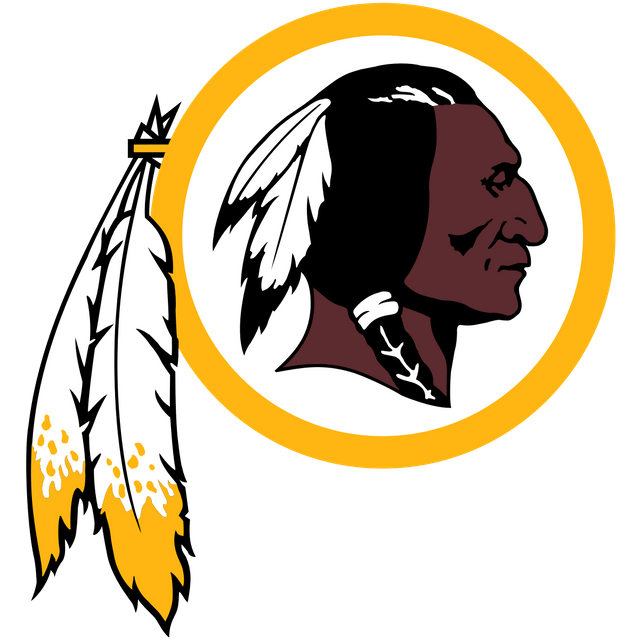
Washington Redskins

| Washington Redskins | |||||
|---|---|---|---|---|---|
| **Established July 9, 1932 (July 9, 1932)** First season: 1932 Play in FedExField Landover, Maryland Headquartered at Redskins Park in Ashburn, Virginia Training camp in Richmond, Virginia | |||||
| |||||
| League/conference affiliations | |||||
National Football League (1932–present)
| |||||
Current uniform | |||||
| Team colors | Burgundy, gold | ||||
| Fight song | Hail to the Redskins | ||||
| Personnel | |||||
| Owner(s) | Daniel Snyder[152] | ||||
| President | Bruce Allen | ||||
| Head coach | Jay Gruden | ||||
| Team history | |||||
| |||||
| Team nicknames | |||||
| |||||
| Championships | |||||
League championships (5)
| |||||
Conference championships (5)
| |||||
Division championships (14)
| |||||
| Playoff appearances (24) | |||||
| Home fields | |||||
| |||||
The Washington Redskins are a professional American football team based in the Washington metropolitan area. The Redskins compete in the National Football League (NFL) as a member of the National Football Conference (NFC) East division. The team plays its home games at FedExField in Landover, Maryland; its headquarters and training facility are at Inova Sports Performance Center at Redskins Park in Ashburn, Virginia and the Redskins Complex in Richmond, Virginia, respectively.
The Redskins have played more than one thousand games since their founding 87 years ago in 1932, and are one of only five franchises in the NFL to record over six hundred regular season and postseason wins, reaching that mark in 2015.[2] The Redskins have won five NFL Championships (the latter three in Super Bowls), and have captured fourteen divisional titles and six conference championships.[3] The Redskins were the first NFL franchise with an official marching band, the Redskins Band, and the first with a fight song, "Hail to the Redskins".[4]
The team began play in Boston as the Braves in 1932, and became the "Redskins" the following year. In 1937, the team relocated to Washington, D.C., where they have been based since.[4] The Redskins won the 1937 and 1942 NFL championship games, as well as Super Bowls XVII, XXII, and XXVI. They have been league runner-up six times, losing the 1936, 1940, 1943, and 1945 title games, and Super Bowls VII and XVIII. With 24 postseason appearances, the Redskins have an overall postseason record of 23–18. Their three Super Bowl wins are tied with the Oakland Raiders and Denver Broncos, behind the Pittsburgh Steelers and New England Patriots (six each), San Francisco 49ers and Dallas Cowboys (five each), and the Green Bay Packers and New York Giants (four each).[5]
All of the Redskins' league titles were attained during two 10-year spans. From 1936 to 1945, the Redskins went to the NFL Championship six times, winning two of them.[4] The second period lasted between 1982 and 1991 where the Redskins appeared in the postseason seven times, captured four Conference titles, and won three Super Bowls out of four appearances.[4] The Redskins have also experienced failure in their history. The most notable period of general failure was from 1946 to 1970, during which the Redskins posted only four winning seasons and did not have a single postseason appearance.[3] During this period, the Redskins went without a single winning season during the years 1956–1968.[3] In 1961, the franchise posted their worst regular season record with a 1–12–1 showing.[3] Since their last Super Bowl victory following the end of the 1991 season, the Redskins have only won the NFC East three times, made five postseason appearances, and had nine seasons with a winning record.
According to Forbes, the Redskins are the fifth most valuable franchise in the NFL, and the 14th most valuable sports franchise in the world as of 2019, valued at approximately US$3.1 billion.[6] They also set the NFL record for single-season attendance in 2007, and have the top ten single-season attendance totals in the NFL.[7] Over the team's history, the name and logo have drawn controversy, with many criticizing it as offensive to Native Americans.
| Washington Redskins | |||||
|---|---|---|---|---|---|
| **Established July 9, 1932 (July 9, 1932)** First season: 1932 Play in FedExField Landover, Maryland Headquartered at Redskins Park in Ashburn, Virginia Training camp in Richmond, Virginia | |||||
| |||||
| League/conference affiliations | |||||
National Football League (1932–present)
| |||||
Current uniform | |||||
| Team colors | Burgundy, gold | ||||
| Fight song | Hail to the Redskins | ||||
| Personnel | |||||
| Owner(s) | Daniel Snyder[152] | ||||
| President | Bruce Allen | ||||
| Head coach | Jay Gruden | ||||
| Team history | |||||
| |||||
| Team nicknames | |||||
| |||||
| Championships | |||||
League championships (5)
| |||||
Conference championships (5)
| |||||
Division championships (14)
| |||||
| Playoff appearances (24) | |||||
| Home fields | |||||
| |||||
Franchise history
Origins and early years (1932–1945)
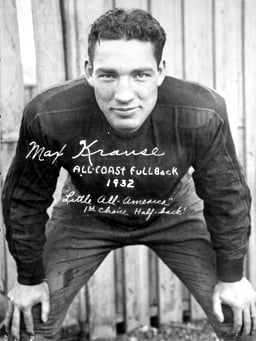
Max Krause was a running back for the Redskins from 1937 to 1940
The team originated as the Boston Braves, based in Boston, Massachusetts, in 1932, under the ownership of George Preston Marshall.[8] At the time the team played in Braves Field, home of the Boston Braves baseball team in the National League. The following year, the club moved to Fenway Park, home of the American League's Boston Red Sox, whereupon owners changed the team's name to "Boston Redskins." To round out the change, Marshall hired William "Lone Star" Dietz, who was thought to be part Sioux, as the team's head coach.[9] However, Boston wasn't much of a football town at the time and the team had difficulty drawing fans.
The Redskins relocated south from New England after five years to the national capital of Washington, D.C. in 1937. Through 1960, the Redskins shared baseball's Griffith Stadium with the first Washington Senators baseball team of the American League.[10] In their first game in Washington, the Redskins defeated the New York Giants in the season opener, 13–3.[11] That same season, they earned their first division title in Washington with a 49–14 win over the Giants.[11] Shortly after, the team won their first league championship, defeating the Chicago Bears.[11] In 1940, the Redskins met the Bears again in the 1940 NFL Championship Game.[12] The result, 73–0 in favor of the Bears, is still the worst one-sided loss in NFL history.[12] The other big loss for the Redskins that season occurred in September during the coin toss prior to the Giants game. After calling the coin toss and shaking hands with the opposing team captain, lineman Turk Edwards attempted to pivot around to head back to his sideline. However, his cleats caught in the grass and his knee gave way, injuring him and bringing his season and hall of fame career to an unusual end.[13]
In what became an early rivalry in the NFL, the Redskins and Bears met two more times in the NFL Championship Game. The third time in 1942, where the Redskins won their second championship, 14–6.[12] The final time the two met was the 1943, which the Bears won 41–21.[12] The most notable accomplishment achieved during the Redskins' 1943 season was Sammy Baugh leading the NFL in passing, punting, and interceptions.[14]
The Redskins played in the NFL Championship one more time before a quarter-century drought that did not end until the 1972 season. With former Olympic gold medalist Dudley DeGroot as their new head coach, the Redskins went 8–2 during the 1945 season. One of the most impressive performances came from Sammy Baugh, who had a completion percentage of .703.[15] They ended the season by losing to the Cleveland Rams in the 1945 NFL Championship Game, 15–14.[12] The one-point margin of victory came under scrutiny because of a safety that occurred early in the game. In the first quarter, the Redskins had the ball at their own 5-yard line. Dropping back into the end zone, quarterback Sammy Baugh threw to an open receiver, but the ball hit the goal post (which at the time was on the goal line instead of at the back of the end zone) and bounced back to the ground in the end zone. Under the rules at the time, this was ruled as a safety and thus gave the Rams a 2–0 lead. It was that safety that proved to be the margin of victory. Owner Marshall was so mad at the outcome that he became a major force in passing the following major rule change after the season: A forward pass that strikes the goal posts is automatically ruled incomplete. This later became known as the "Baugh/Marshall Rule".[16]
Front-office disarray and integration (1946–1970)
The team's early success endeared it to the fans of Washington, D.C. However, after 1945, the Redskins began a slow decline that they did not end until a playoff appearance in the 1971 season.[17] The Redskins had four different head coaches from 1946 to 1951, including former players Turk Edwards and Dick Todd as well as John Whelchel and Herman Ball, and none were successful. But this did not stop George Preston Marshall from trying to make the Redskins the most successful franchise in the league. His first major alteration happened on June 14, 1950, when it was announced that American Oil Company planned to televise all Redskins games, making Washington the first NFL team to have an entire season of televised games.[4][18] His next major change came in February 1952, when he hired former Green Bay Packers coach Earl "Curly" Lambeau.[18] But, after two seasons, Marshall fired Lambeau following the Redskins loss in their exhibition opener to the Los Angeles Rams and hired Joe Kuharich.[18] In 1955, Kuharich led the Redskins to their first winning season in ten years and was named both Sporting News Coach of the Year and UPI NFL Coach of the Year.[19]
In 1961, the Redskins moved into their new stadium called D.C. Stadium (changed to Robert F. Kennedy Memorial Stadium in 1969). The first game in new D.C. Stadium occurred on October 1 in front of 37,767 fans. However, the Redskins failed to hold a fourteen-point lead and lost to the New York Giants 24–21.[20] That same year, Bill McPeak became the head coach and had a record of 21–46–3 over five seasons. During his tenure, he helped draft future stars: wide receiver Charley Taylor, tight end Jerry Smith, safety Paul Krause, center Len Hauss, and linebacker Chris Hanburger.[21] He also helped pull off two important trades, gaining quarterback Sonny Jurgensen from the Philadelphia Eagles and linebacker Sam Huff from the New York Giants.[22]
One reason for the team's struggles was disarray in the front office. Marshall began a mental decline in 1962, and the team's other stockholders found it difficult to make decisions without their boss. Marshall died on August 9, 1969,[20] and Edward Bennett Williams, a minority stockholder who was a Washington local and attorney, was chosen to run the franchise while the majority stockholder, Jack Kent Cooke, lived on the West Coast in Los Angeles and ran his basketball team, the Los Angeles Lakers.[23] In 1966, Otto Graham was hired as the new head coach. Graham coached the Redskins for three seasons, but whatever magic he had as an NFL player disappeared on the sidelines as the team recorded a mark of 17–22–3 during that time period. He resigned after the 1968 season in favor of Vince Lombardi, and became athletic director of the Coast Guard Academy before retiring at the end of 1984.
In 1969, the Redskins hired Vince Lombardi—who gained fame coaching with the Green Bay Packers—to be their new head coach.[24] Lombardi led the team to a 7–5–2 record,[17] their best since 1955, but died of cancer on the eve of the 1970 season.[24] Assistant coach Bill Austin was the interim head coach in 1970, and Washington finished at 6–8.[17]
Integration controversy
During most of this unsuccessful period, Marshall continually refused to integrate the team, despite pressure from The Washington Post and the federal government.[25] On March 24, 1961, Secretary of the Interior Stewart Udall warned Marshall to hire black players or face federal retribution. For the first time in history, the federal government had attempted to desegregate a professional sports team.[26] The Redskins were under the threat of civil rights legal action by the Kennedy administration, which would have prevented a segregated team from playing at the new D.C. Stadium, as it was owned by the U.S. Department of the Interior and thus was federal government property.[27]
In 1962, Washington became the final professional American football franchise to integrate. First, the Redskins drafted running back Ernie Davis of Syracuse, the first black player to win the Heisman Trophy.[26] They also took fullback Ron Hatcher in the eighth round, a player from Michigan State who became the first black to sign a contract with the team.[26] But, in mid-December 1961, Marshall announced that on the day of the NFL draft he had traded the rights to Davis to the Cleveland Browns, who wanted Davis to join the league's leading rusher, Jim Brown, in their backfield. Davis was traded to the Browns for running back Bobby Mitchell (who became a wide receiver in Washington) and 1962 first-round draft choice Leroy Jackson.[26][28] The move was made under unfortunate circumstances – as it turned out that Davis had leukemia, and died without ever playing a down in professional football.[26] The Redskins ended the 1962 season with their best record in five years: 5–7–2. Mitchell led the league with 11 touchdowns, and caught 72 passes and was selected to the Pro Bowl. In time, Mitchell would be joined by other black players like receiver Charley Taylor, running back Larry Brown, defensive back Brig Owens, and guard John Nisby from the Pittsburgh Steelers.[26]
George Allen's revival (1971–1980)
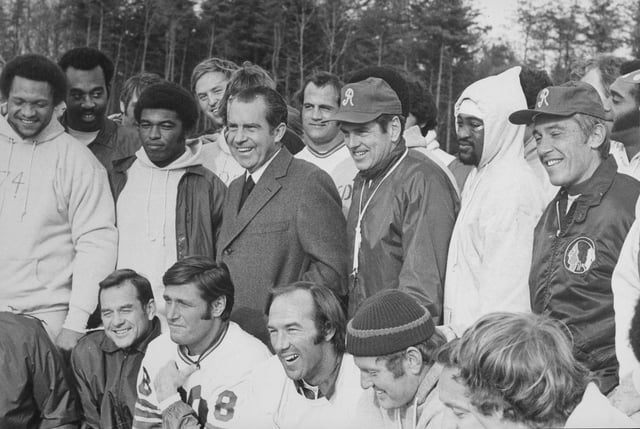
Then U.S. President Richard Nixon meeting with the Redskins, November 23, 1971.
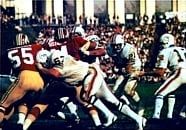
The Redskins playing against the Miami Dolphins in Super Bowl VII
After the death of Lombardi and Austin's unsuccessful 1970 season, Williams signed former Los Angeles Rams head coach George Allen as head coach on January 6, 1971.[29] Partial to seasoned veterans instead of highly touted young players, Allen's teams became known as the Over-the-Hill Gang.[30] That season, the Redskins made the playoffs for the first time since 1945 with a 9–4–1 mark[17] with Redskins first year head coach George Allen winning the 1971 NFL Coach of the Year Award, the second of his career, winning his first Coach of the Year Award in 1967 as the head coach of the Rams. However, they lost in the Divisional Playoffs to the San Francisco 49ers, 24–20.[29] The following season, the Redskins hosted their first post-season game in Washington since 1942, where they beat the Green Bay Packers 16–3 in the NFC Divisional Playoffs.[12] The Redskins reached the NFC Championship Game, and in a much anticipated match-up against the archrival Dallas Cowboys, the Redskins would not disappoint. The Redskins placekicker Curt Knight kicked an 18-yard field goal in the second quarter to get the scoring underway, then Redskins quarterback Billy Kilmer connected with Redskins wide receiver Charley Taylor on a 15-yard touchdown pass and Washington had a 10–3 lead at halftime. In the fourth quarter, Kilmer again went to Taylor, this time for a 45-yard touchdown. Knight added three more field goals that period and The Over-The-Hill-Gang defense allowed only a second-quarter field goal. The final score was Washington 26, Dallas 3. After defeating the Dallas Cowboys to win the NFC Championship, the Redskins went on to lose to the undefeated Miami Dolphins 14–7 in Super Bowl VII.[29] Redskins running back Larry Brown would be named the 1972 NFL's Most Valuable Player.
The Redskins again made the playoffs in 1973, 1974, and 1976, only to lose all three times in the first round.[29] After his Redskins failed to make the playoffs in 1977 despite posting a 9–5 record,[17] Allen was fired and was replaced by new head coach Jack Pardee, a star linebacker under Allen in Los Angeles and Washington.[17] In his first year, his team started 6–0 but then lost 8 of the last 10 games. Then in the offseason, Redskins majority owner Jack Kent Cooke moved from Los Angeles to Virginia and took over the team's day-by-day operations from Edward Bennett Williams.[23]
The Redskins chose well during the 1979 NFL Draft, where they drafted future stars Don Warren and Monte Coleman. They opened the 1979 season 6–2 and were 10–5 heading into the season finale at Texas Stadium, against whom a win would assure a playoff spot and a possible NFC East title. Washington led 34–28 with time running out, but quarterback Roger Staubach then led the Cowboys in a fourth-quarter comeback with two touchdown passes. The 35–34 loss knocked the 10–6 Redskins out of playoff contention.[17] Pardee's quick success with the team did not go unnoticed, however, and he was named Associated Press Coach of the Year and UPI NFC Coach of the Year. Pardee's tenure did not last long though, for he was fired after posting a 6–10 record in 1980.[17] He did, however, draft Art Monk in the first-round.
Joe Gibbs' era (1981–1992)
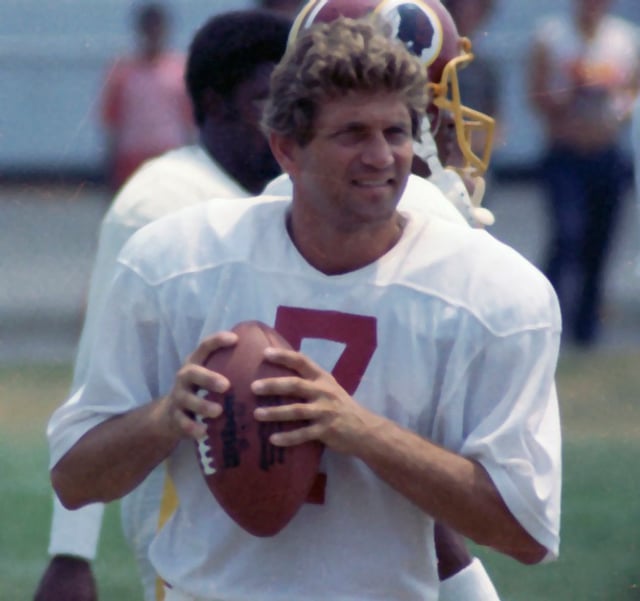
Joe Theismann at Redskins training camp in 1983
On January 13, 1981, owner Jack Kent Cooke signed the offensive coordinator of the San Diego Chargers, Joe Gibbs, as their head coach.[31] Also during the off-season, the Redskins acquired Mark May, Russ Grimm, and Dexter Manley in the 1981 NFL Draft, all of whom became significant contributors to the team for the next few years. After starting the 1981 season 0–5, the Redskins won eight out of their next 11 games and finished the season 8–8.[31] Starting on September 21, 1982,[31] the NFL faced a 57-day long players' strike, which reduced the 1982 season from a 16-game schedule to a nine-game schedule. Because of the shortened season, the NFL adopted a special 16-team playoff tournament, in which eight teams from each conference were seeded 1–8 based on their regular season records. After the strike was settled, the Redskins dominated, winning six out of the seven remaining games to make the playoffs for the first time since 1976.[17]
In January 1983, during the second round of the playoffs against the Minnesota Vikings, John Riggins rushed for a Redskins playoff record 185 yards, leading Washington to a 21–7 win. The game is perhaps best known for a moment when the stadium physically shook as a crowd chanted "We Want Dallas!", which later became a rallying cry of sorts for Redskin fans before games against the Cowboys.[32] In the NFC Championship Game against them at Robert F. Kennedy Memorial Stadium, Redskins defensive end Dexter Manley knocked Cowboys' quarterback Danny White out for the rest of the game and sent him into the locker room shortly before halftime. Later in the game, Redskins defensive tackle Darryl Grant's interception which he returned for a 10-yard touchdown off one of Cowboys' backup quarterback Gary Hogeboom's passes which was tipped by Dexter Manley to score the decisive points. John Riggins rushed for 140 yards and two touchdowns on 36 carries and the Redskins went on to defeat the Cowboys' by a score of 31–17.[31] The Redskins' first Super Bowl win, and their first NFL Championship in 40 years, was in Super Bowl XVII, where the Redskins defeated the Miami Dolphins 27–17.[12] Riggins provided the game's signature play when, on 4th and inches, with the Redskins down 17–13, the coaches called "70 Chip", a play designed for short yardage.[33] Riggins instead gained 43 yards (39 m) by running through would-be tackler Don McNeal and getting the go-ahead touchdown. The Redskins ended up winning by a 27–17 score with John Riggins winning the Super Bowl MVP.
After the 1982 season Redskins placekicker Mark Moseley was the first and only placekicker in NFL history to be named the NFL's Most Valuable Player; Moseley made 20 of 21 field goals attempted in 1982. Redskins head coach Joe Gibbs also won his first NFL Coach of the Year Award in 1982 which was the first of his back to back NFL Coach of the Year Awards, his second coming in the 1983 NFL season.
The 1983 season marked the rookie debut of cornerback Darrell Green, selected in the 1983 NFL Draft along with Charles Mann, Green would go on to play his entire 20-year NFL career for the Redskins. On October 1, 1983, the Redskins lost to the Green Bay Packers 48–47 in the highest scoring Monday night football game in history, in which both teams combine for more than 1,000 yards (910 m) of total offense.[31] Then during the regular-season finale on December 17, 1983, Moseley set an NFL scoring record with 161 points while Riggins' total of 144 points was second. This marked the first time since 1951 that the top two scorers in a season played on the same team.[31] They dominated the NFL with a 14-win season which included scoring a then NFL record 541 points,[34] many of which came from Riggins, who scored 24 touchdowns. Redskins quarterback Joe Theismann would also be named the 1983 NFL's Most Valuable Player finishing the season with a career-high in both yards passing 3,714 yds., and touchdown passes thrown, 29 Td's while throwing only 11 interceptions. In the postseason, the Redskins beat the Los Angeles Rams 51–7.[12] The next week, Washington beat the San Francisco 49ers 24–21 in the NFC Championship Game.[12] It was their final win of the season because two weeks later, the Raiders beat the Redskins 38–9 in Super Bowl XVIII.[12]
The Redskins finished the 1984 season with an 11–5 record,[17] and won the NFC East for the third consecutive season.[31] However, they lost in the first round of the playoffs to the Chicago Bears, 23–19.[12] On November 18, 1985, while playing against the Giants, Theismann broke his leg during a sack by Lawrence Taylor. The compound fracture forced him to retire after a 12-year career, during which he became the Redskins' all-time leader in pass attempts and completions.[31] The Redskins finished 3rd in the NFC East behind the Cowboys and missed the wild card to the Giants by virtue of tiebreakers.
The 1986 offseason's major highlight occurred during the 1986 NFL Draft, when the Redskins picked up future Super Bowl MVP Mark Rypien in the sixth round, also the Redskins defensive end Dexter Manley set a franchise single season record when he recorded 18.5 sacks while earning 1st Team All-Pro honors and being selected to the Pro bowl. In 1986 season, the road to the playoffs was even harder, with the Redskins making the postseason as a wild-card team despite having a regular season record of 12–4.[17] They won the Wild Card playoff against the Rams, and then again in the Divisional playoffs against the Bears. This game was Gibbs 70th career, which made him the winningest head coach in Redskins history.[31] The season ended next week, however, when the Redskins lost to the eventual Super Bowl XXI Champion Giants 17–0 in the NFC Championship game.[12][31]
The 1987 season began with a 24-day players' strike, reducing the 16-game season to 15. The games for weeks 4–6 were won with all replacement players. The Redskins have the distinction of being the only team with no players crossing the picket line.[35] Those three victories are often credited with getting the team into the playoffs and the basis for the 2000 movie The Replacements. The Redskins won their second championship in Super Bowl XXII on January 31, 1988, in San Diego, California. The Redskins routed the Denver Broncos 42–10[12] after starting the game in a 10–0 deficit, the largest come-from-behind victory in Super Bowl history, which was tied by the New Orleans Saints in Super Bowl XLIV and the New England Patriots in Super Bowl XLIX. This game is more famous for the stellar performance by quarterback Doug Williams who passed for four touchdowns in the second quarter en route to becoming the first black quarterback to lead his team to a Super Bowl victory while also winning the games Super Bowl MVP award.[36] Rookie running back Timmy Smith had a great performance as well, running for a Super Bowl record 204 yards (187 m).[36]
1988 started off with a boom and the club had a 5–3 record at mid-season, but a 2nd half swoon saw them miss the playoffs with a 7–9 record.
The 1989 Redskins finished with a 10–6 record but missed the playoffs. That season is best remembered for the Redskins prolific wide receiver trio nicknamed "The Posse" consisting of wide receivers Art Monk, Gary Clark, and Ricky Sanders who became the first trio of wide receivers in NFL history to post 1,000-plus yards in the same season. Also, in a week 14 victory against the San Diego Chargers, Redskins head coach Joe Gibbs achieved career victory no. 100.
The Redskins returned to the playoffs in 1990 as a wild card team, lost in the Divisional playoffs to the 49ers, 28–10.[12]
The 1991 season started with a franchise-record 11 straight victories.[37] Also during the season, "The Hogs",[37] under the coaching of Redskins offensive line coach Joe Bugel, allowed a league low and franchise record nine sacks – the third lowest total in NFL history. The 1991 Redskins offense also dominated under the brilliant coaching of offensive minded head football coach Joe Gibbs scoring 485 points which was the most by any team in the 1991 NFL season. The 1991 Redskins defense was also dominant under the coaching of defensive coordinator and guru Richie Petitbon, giving up only 224 total points which was second best of any team in the NFL in 1991, while also not allowing a single point to opponents in 3 of the 16 games played that season. After posting a 14–2 record, the Redskins made and dominated the playoffs, beating the Falcons and Lions by a combined score of 64–17.[12] On January 26, 1992, the Redskins won Super Bowl XXVI by defeating the Buffalo Bills 37–24[12] with Mark Rypien winning the games Super Bowl MVP award. After the Super Bowl, the Redskins set another franchise record by sending eight players to the Pro Bowl.[37] The 1991 Washington Redskins are widely considered one of the best teams in NFL history.
The Redskins success in 1992 culminated in a trip to the playoffs as a wild card team, but they lost in the Divisional playoffs to the 49ers, 20–13.[12] The most impressive feat during the season occurred on October 12, 1992, when Art Monk became the NFL's all-time leading pass receiver against the Denver Broncos on Monday Night Football by catching his 820th career reception.[37] The era ended on March 5, 1993, when Joe Gibbs retired after 12 years of coaching with the Redskins.[37] In what proved to be a temporary retirement, Gibbs pursued an interest in NASCAR by founding Joe Gibbs Racing.[38]
End of RFK and Cooke ownership (1993–1998)
After the end of Gibbs' first tenure, the Redskins hired former Redskins player Richie Petitbon for the 1993 season. However, his first and only year as head coach, the Redskins finished with a record of 4–12.[17] Petitbon was fired at the end of the season and on February 2, 1994, Norv Turner was hired as head coach after being the offensive coordinator of the Dallas Cowboys.[37] 1994 was even worse as they finished 3–13, their worst season in over 30 years. Their sole bright spot that year came on October 9, 1994, linebacker Monte Coleman played in his 206th career game with the Redskins, which broke Art Monk's team record for games played (Coleman retired at season's end with 216 games played).[37] They improved to 6–10 in 1995 where they were able to get a season sweep on the eventual Super Bowl XXX Champions the Dallas Cowboys. On March 13, 1996, Redskins owner Jack Kent Cooke, Maryland Governor Parris Glendening, and Prince George's County Executive Wayne K. Curry signed a contract that paved the way for the immediate start of construction for the new home of the Redskins (now FedExField).[37] The 1996 season saw Washington post their first winning record in 4 years by finishing 9–7. On December 22, 1996, the Redskins played their final game at Robert F. Kennedy Memorial Stadium, a victory over the Dallas Cowboys 37–10, and finished their tenure at the stadium with a 173–102–3 record, including 11–1 in the playoffs.[37]
On April 6, 1997, Redskins owner Jack Kent Cooke died of congestive heart failure at the age of 84.[37] In his will, Cooke left the Redskins to the Jack Kent Cooke Foundation, with instructions that the foundation sell the team. His estate, headed by son John Kent Cooke, took over ownership of the Redskins and at his memorial service, John Kent Cooke announced that the new stadium in Landover, Maryland would be named Jack Kent Cooke Stadium.[37] On September 14, 1997, the Redskins played in their new stadium for the first time, and beat the Arizona Cardinals, 19–13 in overtime.[37] On November 23, 1997, they played the New York Giants and the result was a 7–7 tie, the Redskins first tie game since the 1971 season. They would finish 1997 8–7–1 and would miss the playoffs for a fifth season in a row. One bright spot during the season, however, occurred on December 13, 1997, when Darrell Green played in his 217th career game as a Redskin, breaking Monte Coleman's record for games played.[37]
The 1998 season started with a seven-game losing streak,[39] and the Redskins finished with a 6–10 record.
Daniel Snyder ownership era (1999–present)
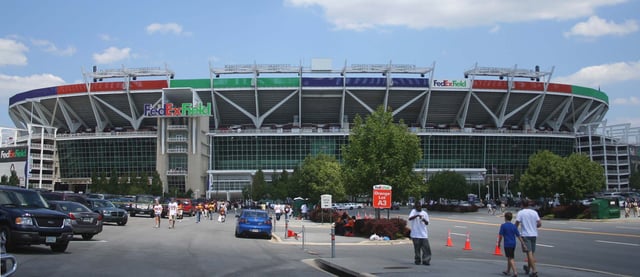
FedExField
After two seasons, John Kent Cooke was unable to raise sufficient funds to permanently purchase the Redskins, and on May 25, 1999, Daniel Snyder gained unanimous approval (31–0) from league owners and bought the franchise for $800 million,[37] a deal that was the most expensive team-purchasing deal in sporting history.[40] One of his first acts as team owner occurred on November 21, 1999, when he sold the naming-rights to Jack Kent Cooke Stadium to the highest bidder, Federal Express, who renamed the stadium FedExField.[37]
In Snyder's first season as owner, the Redskins went 10–6,[17] including a four-game winning streak early in the season,[41] and made it to the playoffs for the first time in Norv Turner's career (and the first time for the Redskins since 1992) in the final game of the season (on January 2, 2000 against the Dolphins). Running back Stephen Davis rushed for a then club-record 1,405 yards and quarterback Brad Johnson completed a then club-record 316 passes and threw for more than 4,000 yards in regular play that season.[42] They then beat the Detroit Lions in the first round of the playoffs, but lost to the Buccaneers, 14–13.
The 2000 season started with the selection of future Pro Bowler Chris Samuels and the tumultuous LaVar Arrington in the 2000 NFL Draft and included five consecutive wins in the first half of the season.[43] However, they ended up going 7–6, and on December 4, 2000, Norv Turner was fired as head coach.[42] Terry Robiskie was named interim coach to finish out the season,[42] which ended with an 8–8 record.[17] During the final game of the season on December 24, 2000, Larry Centers became the NFL's all-time leader in catches by a running back with 685 receptions.[42]
Marty Schottenheimer era (2001)
On January 3, 2001, the Redskins hired former Browns and Chiefs head coach Marty Schottenheimer as head coach.[42] The 2001 season began with a loss to the San Diego Chargers, 30–3, two days before the September 11, 2001, attacks. On September 13, 2001, the Redskins announced the establishment of the Redskins Relief Fund to help families of the victims of the attack at the Pentagon. During the course of the season, the Redskins raised more than $700,000.[42] They finished the season with an 8–8 record[17] and Schottenheimer was fired after the final game. Snyder later said in a 2013 interview on the firing of Schottenheimer, "I like Marty and still do to this day, we are good friends, he'd still be here if he didn't want to do it all. He was insistent on doing it all, that was something that I don't think works, one guy can't do everything, he was a machine on that front. He wouldn't drop the personnel side and give us a chance at more of a team energy."[44]
Steve Spurrier era (2002–2003)
2002
On January 14, 2002, Snyder hired University of Florida coach Steve Spurrier,[42] the Redskins' fifth new head coach in 10 years. They finished with a 7–9 record, their first losing season since 1998.[17] A bittersweet moment during the season occurred on December 29, 2002, when Darrell Green concluded his 20th and final season as the Redskins defeated the Cowboys 20–14 at FedExField. During his 20 seasons, he set a NFL record for consecutive seasons with at least one interception (19) and a Redskins team record for regular season games played (295) and started (258).[42]
2003
The Redskins finished the 2003 season with a 5–11 record, their worst since 1994.[17] The one bright note of the season was on December 7, 2003, when defensive end Bruce Smith sacked Giants quarterback Jesse Palmer in the fourth quarter. With his 199th career sack, broke Reggie White's all-time NFL mark (Smith finished the season with 200 career sacks).[42] After two mediocre years, Spurrier resigned after the 2003 season with three years left on his contract.
Return of Joe Gibbs (2004–2007)
2004
For the 2004 season, Snyder successfully lured former coach Joe Gibbs away from NASCAR to return as head coach and team president. His employment came with a promise of decreased intervention in football operations from Snyder.[45] Snyder also expanded FedExField to a league-high capacity of 91,665 seats. Gibbs' return to the franchise did not pay instant dividends as the Redskins finished the 2004 season with a record of 6–10.
Despite an impressive defense, the team struggled offensively. Quarterback Mark Brunell—an off-season acquisition from the Jacksonville Jaguars—struggled in his first season, and was replaced midway through the season by backup Patrick Ramsey. On the other hand, some of Gibbs' other new signings, such as cornerback Shawn Springs and linebacker Marcus Washington, did very well. The Redskins also picked Sean Taylor from University of Miami during the draft in Gibbs' first season.
2005
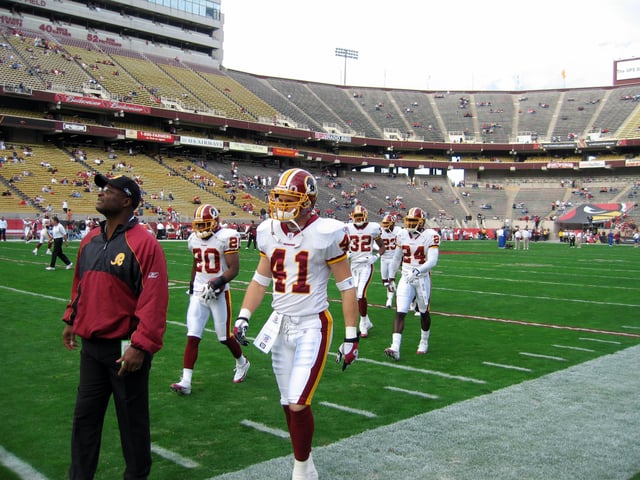
Redskins on the field in 2005
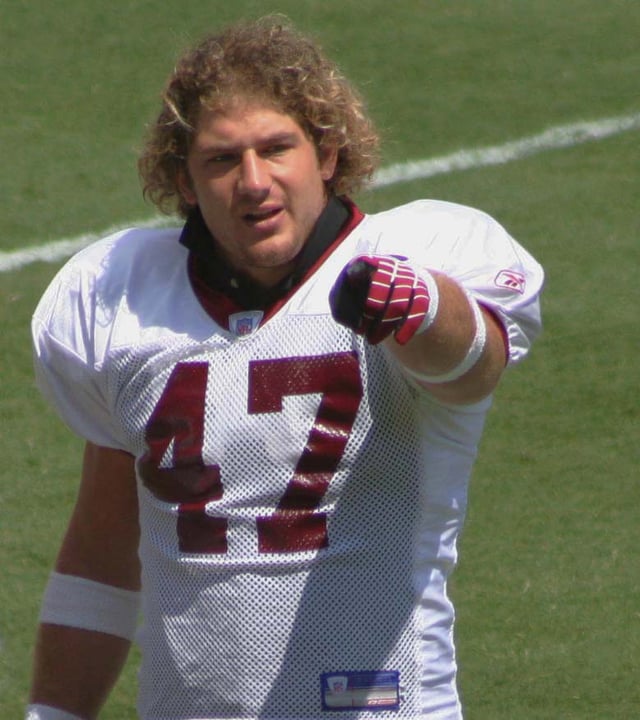
Chris Cooley was a starting tight end for the Redskins in the 2000s
The beginning of the 2005 season started with three wins,[46] including a Monday Night Football game on September 19, 2005, against the Dallas Cowboys. Dallas led 13–0 with less than four minutes left when Brunell threw a 39-yard (36 m) touchdown pass to Moss on a fourth-down play. Then, with 2:44 left, Brunell connected with Moss again on a 70-yard (64 m) touchdown pass and Nick Novak kicked the game-winning extra point. It was the Redskins' first victory at Texas Stadium since 1995.[42] They then fell into a slump, losing six of the next eight games which included three straight losses in November,[46] and their playoffs chances looked bleak.
However, the Redskins then went on to record five consecutive victories at the end of the season, which concluded with the Redskins winning three games in a row against division rivals.[46] On December 18, 2005, they beat Cowboys, 35–7, which marked the first time since 1995 that the Redskins were able to sweep the season series with Dallas.[42] The Redskins then avenged the earlier loss to the Giants with a 35–20 victory in their last regular-season home game.[46] They finished out the season against the Philadelphia Eagles on January 1, 2006, where they won with a 31–20, with Taylor returning a fumble 39 yards (36 m) for a touchdown to seal the victory. The win clinched their first playoff berth since 1999.[42] The game also culminated impressive season performances by individuals. Portis set a team mark for most rushing yards in a single season with 1,516 yards (1,386 m), and Moss set a team record for most receiving yards in a single season with 1,483 yards (1,356 m), breaking Bobby Mitchell's previous record set in 1963.[42] Also, Chris Cooley's 71 receptions broke Jerry Smith's season record for a Redskins tight end.
Finishing the season 10–6, they qualified for the playoffs as a wild card team. Their first game was against the NFC South Champion Buccaneers on January 7, 2006.[42] The Redskins won 17–10,[12] after taking an early 14–0 lead, which they thought they lost until replay showed that a touchdown, which would have tied the game, was an incomplete pass. In that game, the Redskins broke the record for fewest offensive yards (120) gained in a playoff victory, with one of their two touchdowns being from a defensive run after a fumble recovery. The following weekend, they played the Seahawks, who defeated the Redskins 20–10,[12][42] ending their hopes of reaching their first NFC Championship Game since 1991.[12]
2006
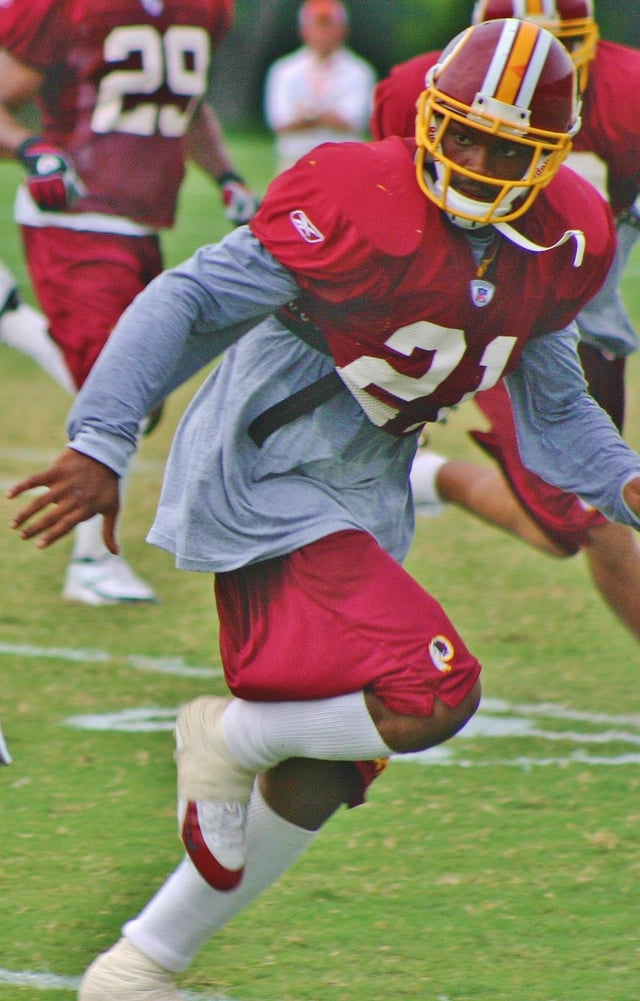
Redskins' safety Sean Taylor during practice
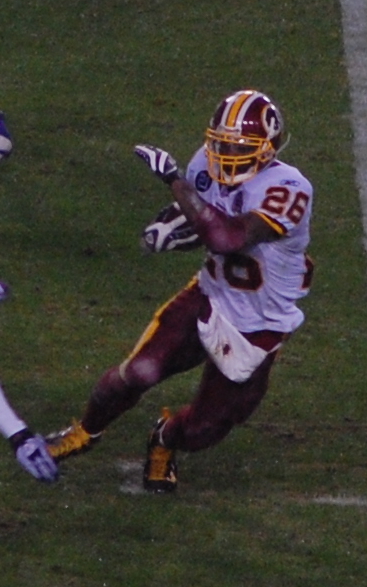
Redskins' running back Clinton Portis, 2007.
The first major move of the 2006 off-season was the hiring of Kansas City Chiefs' offensive coordinator Al Saunders as Associate Head Coach, Offense. Gibbs also added former Buffalo Bills defensive coordinator Jerry Gray to his staff as Secondary/Cornerbacks coach and lost quarterbacks coach Bill Musgrave to the Falcons. The Redskins also picked up future starters Rocky McIntosh, Anthony Montgomery, Reed Doughty, and Kedric Golston in the 2006 NFL Draft.
After winning only three of the first nine games of the 2006 season,[47] Gibbs benched quarterback Brunell for former first-round draft pick Jason Campbell. After losing his first game as a starter to Tampa Bay, Campbell got his first NFL victory against the Carolina Panthers, bringing the Redskins out of a three-game losing streak.[47] The highlight of the season happened on November 5, 2006, and concluded with one of the most exciting endings in the history of the Cowboys–Redskins rivalry. Tied 19–19, Troy Vincent blocked a last-second field goal attempt by Dallas that would have given them the win. Sean Taylor picked up the ball and ran 30 yards (27 m), breaking tackles along the way. It was thought that the game would then go in overtime, however because of a defensive 15-yard (14 m) face mask penalty, the Redskins would get a field goal chance with no time on the clock. Novak kicked a 47-yard (43 m) field goal, giving Washington a 22–19 victory.[42]
They finished the year with a 5–11 record, which resulted in them being last in the NFC East, and the only team in the division to fail to make the playoffs. This marked the second losing season of Joe Gibbs' second term as head coach with the Redskins, compared to the one losing season he had in his first 12-year tenure as head coach. Despite the failures of the 2006 season, including free agent disasters Adam Archuleta and Brandon Lloyd, the year did see improvement in running back Ladell Betts and Campbell as quarterback.
2007
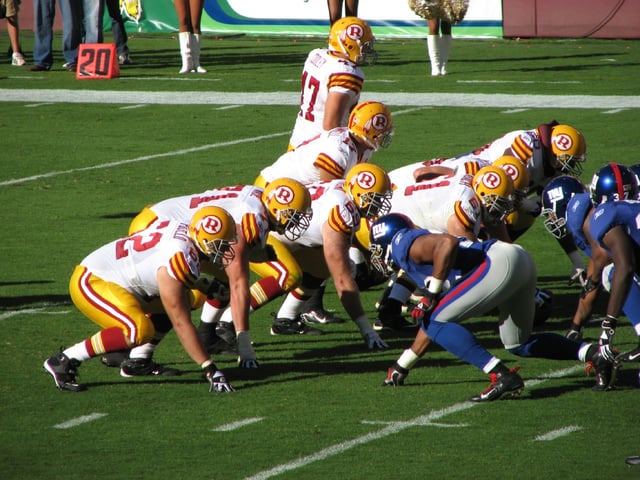
The Redskins gather at the line of scrimmage against the New York Giants
The 2007 Washington Redskins season was the team's 75th season, and saw the team achieve a record of 9–7 and a playoff appearance. This was an improvement over the 2006 season in which they went 5–11 and finished last in the NFC East.
The Redskins began the 2007 season by "winning ugly" starting the season off 2–0. The Redskins kept winning and losing close games, the only exception to this a 34–3 rout of the Detroit Lions. The Redskins continued to win ugly and lose ugly to be 5–3 at the halfway mark. However, the Redskins would begin to collapse. The Washington Redskins lost their next three games to fall to 5–6. On Monday, November 26, 2007, Redskins superstar, Sean Taylor was shot by intruders early in the morning in his Miami home. The next morning, Sean Taylor died from severe blood loss.[48] The heartbreak continued for the Washington Redskins, taking a 9–2 halftime lead against the Buffalo Bills, and eventually a 16–5 lead. However, the Bills cut the lead to 16–14, and got into position with just 8 seconds remaining to win the game. In an attempt to ice the kicker, head coach Joe Gibbs called timeout. However, he attempted to re-ice him, and called timeout again, which drew an unsportsmanlike conduct penalty, reducing the field goal from 51 yards to 36, and Bills kicker Rian Lindell nailed it with ease. Following the heartbreaking loss, the Redskins attended Sean Taylor's funeral two days later, with a game to play on Thursday night against the Chicago Bears. The bad news continued, as quarterback Jason Campbell went down for the season with a knee injury. Following this, unlikely hero and backup quarterback Todd Collins led the Redskins to the victory, keeping their playoff hopes alive. Things continued to turn in the right direction behind Collins, who led the Redskins to a 22–10 victory on Sunday Night Football over the New York Giants and routs of the Minnesota Vikings and rival Dallas Cowboys in the final two weeks to propel the Redskins to 9–7 and the final playoff spot in the NFL playoffs.
The Washington Redskins trailed 13–0 entering the 4th quarter to the Seattle Seahawks in the Wild Card Playoffs, but rallied back to take a 14–13 lead, but Redskins kicker Shaun Suisham missed a field goal later in the game, and the Seahawks scored on the next drive and converted the two-point conversion. To close the game, Todd Collins threw two interceptions, each returned for touchdowns, and the Redskins fell 35–14.
Jim Zorn era (2008–2009)
2008
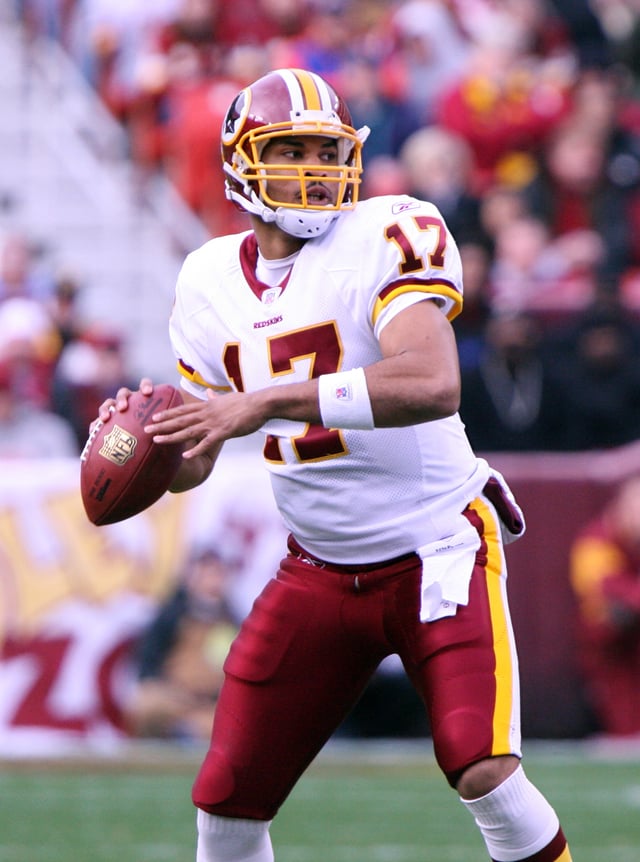
Quarterback Jason Campbell played for the Redskins from 2005–2009
The Washington Redskins looked to return to the playoffs in 2008 but did not succeed, finishing 8–8. After Joe Gibbs announced his retirement, Jim Zorn was hired as head coach, and brought in a West Coast Offense.
The season started about as well as it could have, as the Washington Redskins started the season 6–2, with their two losses coming by a combined 11 points to the New York Giants and St. Louis Rams. Furthermore, Redskins star Clinton Portis led the NFL in rushing yards and Jason Campbell was just 40 pass attempts away from breaking Bernie Kosar's record of consecutive passes to start the season without an interception. However, things turned for the worse on the eve of the 2008 Presidential Election, when they were routed 23–6 by the Pittsburgh Steelers and Clinton Portis' injuries finally caught up to him. The Redskins continued to struggle, falling all the way to 7–7, with their only win during that six-week period being a 3-point victory of the then-2–8 Seattle Seahawks, who would finish the season 4-12. The Redskins managed to upset the Philadelphia Eagles in Week 16, but were eliminated from playoff contention after the Atlanta Falcons defeated the Minnesota Vikings 24–17 that same week. The Redskins lost the final game of the season 27–24 to the San Francisco 49ers, despite having a 17–7 lead at halftime, losing on a Joe Nedney field goal as time expired.
2009
The Redskins' fortunes continued to slide in 2009, as they lost two of the first four matches, one of which was a 19-14 defeat at the hands of the Lions, a team that had not won a game since December 2007. After that, they lost to Carolina on the road and Kansas City at home, the latter match handing another victory to a winless team. On Monday Night Football, the Redskins lost to Philadelphia in a game where Jim Zorn was temporarily relieved of his duties by offensive coordinator Sherman Lewis. In Week 10, they inflicted a surprise defeat on the Denver Broncos before losing two divisional matches to Dallas and Philadelphia. The Week 13 game against an undefeated Saints team proved another surprise. The Redskins managed to tie at the end of regulation, and in overtime had a chance to break New Orleans' winning streak. However, kicker Shaun Suisham missed a field goal that would have given them the victory. On their next possession, the Saints scored a FG and won the game 33-30. Suisham was cut after the game and signed with Dallas (his original team). The Redskins then routed Oakland in Week 14 before losing their last three games to finish 4-12. The second match with the Cowboys ended in a 16-0 shutout, making for only the second season since 1970 where Washington lost all of its divisional matches. Jim Zorn was fired and replaced by Mike Shanahan afterwards.
Mike Shanahan era (2010–2013)
2010
The 2010 off-season would bring a surprise when on April 4, Eagles QB Donovan McNabb forced his team to trade him to the Redskins and was also marred by contract disputes with Albert Haynesworth. Washington continued an old tradition of playing its arch-rival Cowboys in the first week of the season. Both teams were unimpressive and the Redskins' offense sputtered throughout the game, but they finally won 13-10 after a touchdown pass by Tony Romo was nullified after a holding call. They hosted the Texans in Week 2, but good all-around offensive performance (especially by McNabb, who passed for 426 yards and a touchdown) failed to secure a win. The game tied at 27-27 and went into overtime where Houston kicker Neil Rackers made a 37-yard FG, ending the match at 30-27. After this, the Redskins lost to St. Louis 30-16 before McNabb's return to Philadelphia. Although Washington did not deliver a particularly strong performance, they won 16-12 after Eagles QB Michael Vick was injured and replaced by Kevin Kolb. In Week 5, they hosted Green Bay for only the second time since 1979 (the first was in 2004) and beat them 16-13. After losing a Sunday Night match to the Colts, Washington beat Chicago in Week 7. Although McNabb threw two interceptions, the team took advantage of their opponent's porous O-line to sack and pick off Jay Cutler four times, winning 17-14. After losing a 37-25 trap game in Detroit, the Redskins went on their bye week and returned to host Philadelphia on MNF for the second straight year. As rain fell on Fedex Field, the Eagles proceeded to crush Washington 59-28 with eight touchdowns. In contrast to the huge numbers put up by Michael Vick, McNabb looked decidedly unimpressive, with two touchdown passes and three interceptions (one returned for a TD). Just before the game, he had finalized his contract with the Redskins, who gave him a 5-year, $78 million deal and allowing him to (barring unforeseen circumstances) finish out his career in Washington. After beating Tennessee, the Redskins lost four straight games and were removed from playoff contention before beating Jacksonville in Week 16. After losing to New York at home, the Redskins finished the year at 6-10 and once again 4th place in the division.
2011
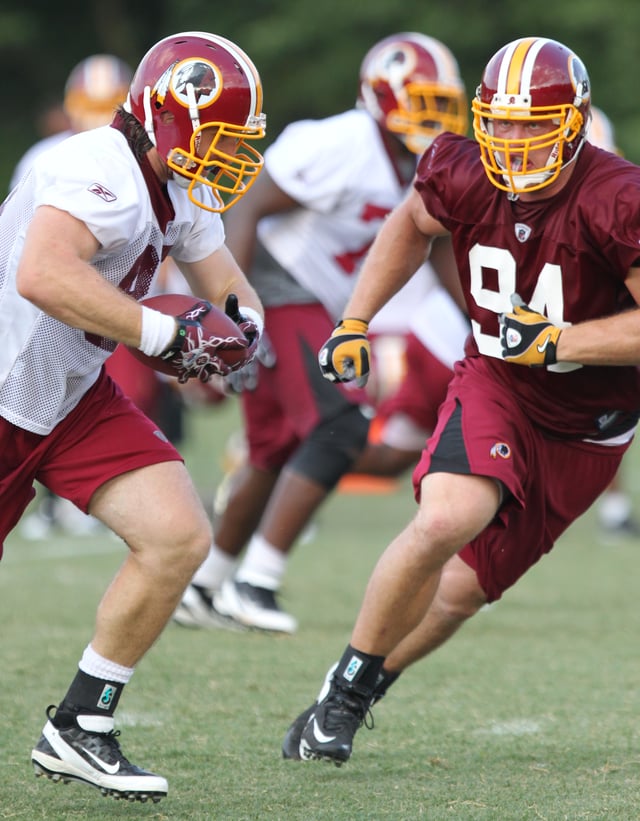
Redskins training camp, 2011
The McNabb era came to an abrupt end when he was traded to Minnesota in August 2011. The troublesome Albert Haynesworth also headed to New England. After cutting the injury-rattled Clinton Portis, the Redskins had no important offensive players left except for Santana Moss. Mike Shanahan surprised most observers by his decision to name John Beck, an obscure free agent QB, as the starter.
However, Shanahan suddenly reversed direction by naming veteran backup Rex Grossman to the starting position. In Week 1, Grossman threw for 305 yards and two TD passes as the Redskins crushed the Giants 28-14, ending a six-game losing streak against that team. After beating the Cardinals in Week 2, the Redskins got off to a surprise 2-0 start. In Week 3, they played the Cowboys on MNF and lost a poorly played game where the latter edged them out with six field goals to win 18-16.
After beating the Rams in Week 4, the Redskins disintegrated from injuries and didn't win another game until Seattle in Week 12. They finished 5-11 following a second win over the eventual champion Giants.
2012
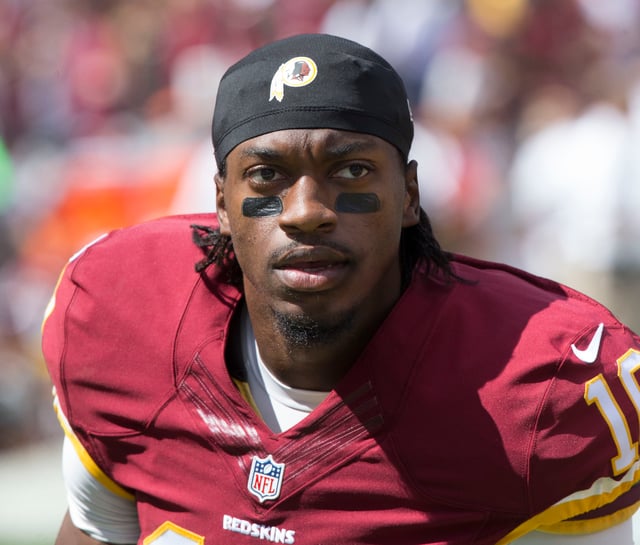
Quarterback Robert Griffin III won the league's Offensive Rookie of the Year award in 2012, while also leading the team to their first division title since 1999.
The Redskins traded all their high level draft picks to St. Louis for taking Baylor QB Robert Griffin III #2 in the 2012 draft. Although the need for a franchise QB was obvious, many football experts doubted the wisdom of such a trade for one player. Griffin silenced his critics in Week 1 as Washington won a surprise upset over the Saints in New Orleans. The rookie QB threw for 320 yards and two TD passes in a 40-32 victory for the Redskins' highest scoring game since 2005.
In Week 2, the team traveled to St. Louis where they lost 24-22. A major defensive loss was suffered when Brian Orakpo went down from a tear to his left pectoral muscle. Despite widespread complaints from Redskins fans and players about the Rams playing dirty, there was nothing to do but move on to the home opener against Cincinnati. The game started on a bad omen when the Bengals threw a 76-yard TD pass on the opening drive. Although the Redskins responded furiously and played another close match, they lost and injuries continued to pile up as CB Josh Wilson and WR Pierre Garçon went down. They would win their next game on a late game field goal at Tampa Bay, 24-22, after the Buccaneers made a 4th quarter comeback to take the lead. The Redskins only won one of their next five games, going into the bye week at 3-6.
In Week 11, the Redskins would face the struggling Philadelphia Eagles in Washington. RGIII would have one of his best games of his career to date, as the Redskins won 31-6 with long touchdowns to Santana Moss and Aldrick Robinson. The Redskins would win their next 6 games after that, including a Thanksgiving Day win over the Dallas Cowboys, an overtime win against the eventual champs, the Baltimore Ravens, and a 38-21 win over the Cleveland Browns that featured backup rookie quarterback Kirk Cousins as the starter, filling in for RGIII who got an injured knee against the Ravens. The Redskins would win their crucial last game against the Cowboys, which would clinch the division for them and send the Redskins to the playoffs.
2013
After winning the NFC East in the previous season, hopes were high for a repeat in 2013. However, these hopes were in vain, as poor play and controversy stirred during the entire year, leading to the disastrous record of 3–13. This was the worst record the Redskins have posted since 1994. Even though most players had a down year compared to last season, Pierre Garçon had his greatest season statistically yet. Garcon eventually broke Art Monk's 29-year-old franchise record for catches in a single season. Garcon had 113 catches total, which broke Monk's 106 catches in 1984 by seven.[49]
The Washington Redskins fired Shanahan and most of his staff on December 30, 2013.[50]
Jay Gruden era (2014–present)
2014
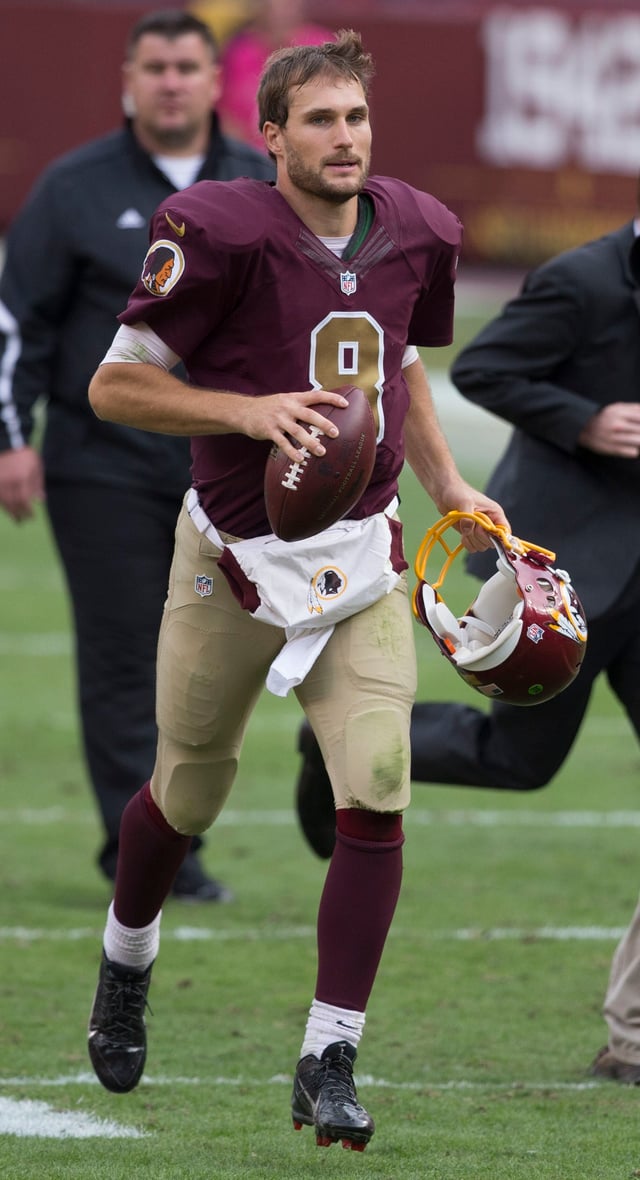
Quarterback Kirk Cousins after the comeback victory against the Tampa Bay Buccaneers in 2015, the largest in franchise history
On January 9, 2014, the Redskins hired Jay Gruden as their head coach. Gruden became the eighth head coach of the team since Daniel Snyder purchased the franchise in 1999.[51] Gruden lost his first regular season game as an NFL coach against the Houston Texans 17–6 with the Texans defense controlling the Washington offense for the majority of the game. Gruden would then go on to win his first game as an NFL head coach the following week against the Jacksonville Jaguars 41–10. Gruden and the Redskins struggled throughout the season, having three different quarterbacks start games, amounting to a 4–12 record. Defense coordinator Jim Haslett was fired at the end of the season.[52]
2015
On January 7, 2015, the Redskins hired Scot McCloughan to be their general manager.[53] McCloughan took over control of the roster from Bruce Allen, who was given the sole title of team president after the hiring. On October 25, 2015, the Redskins had their largest comeback win in franchise history, coming back to win against the Tampa Bay Buccaneers 31–30, after being down 0–24 in the second quarter.[54]
The Redskins clinched the NFC East division title on December 26, when they beat the Philadelphia Eagles in Week 16, 38–24.[55] The division title was their third since Snyder took over ownership of the team, and was the first since the 1999 season to be clinched before Week 17. The Redskins hosted the Green Bay Packers in the Wild Card round on January 10, 2016, but lost 35–18, ending their 2015 season.[56]
Kirk Cousins, who took over as starting quarterback in the preseason, finished the season with career highs in touchdowns (29), yards (4,166), and completion percentage (69.8%). His completion percentage led the league, while his 29 touchdowns tied him for second on the franchise single-season list.[57]
2016
The team's offense in 2016 set several franchise records, including having over 6,000 total net yards, which was only the third time in franchise history the team had accomplished that.[58] Quarterback Kirk Cousins also set single-season team records in attempts, completions, and passing yards, breaking many of his records he had previously set in 2015.[58] DeSean Jackson, Pierre Garçon, Jamison Crowder, Robert Kelley, Chris Thompson, Jordan Reed, Vernon Davis, and Matt Jones all finished the season with at least 500 yards from scrimmage, tying the 2011 New Orleans Saints for the most in a single season in NFL history.[58]
Despite the numerous records set, the Redskins missed the playoffs, losing 19–10 in a "win and in" situation against the New York Giants in the final week of the season.[59] However, the Redskins still finished the season with a record of 8–7–1, giving the team their first consecutive winning seasons in nearly 20 years.[60] In contrast with the record setting offense, the team's defense had a poor season, finishing 29 out of 32 teams in total defense, which led to the firing of defensive coordinator Joe Barry, as well as three of his assistants.[61]
2017
2017 was the team's 85th season. Kirk Cousins had his third straight season with 4,000 passing yards while once again playing under the franchise tag. For the fifth straight season, the Redskins missed the playoffs, finishing 7-9. It was also the last season that Cousins was seen in a Redskins uniform before joining the Minnesota Vikings following the season, ending his 6-year tenure with the Redskins.
Logos and uniforms
The Washington Redskins' primary colors are burgundy and gold.[62][63] Continuously from 1961 through 1978, the Redskins wore gold pants with both the burgundy and white jerseys, although details of the jerseys and pants changed a few times during this period. Gold face masks were introduced in 1978 and remain to this day; previous to that they were grey. From the start of the Joe Gibbs era until 2010, the Redskins were one of three NFL teams that primarily wore their white jerseys at home (the others being the Dallas Cowboys and Miami Dolphins). The tradition of wearing white jerseys over burgundy pants at home, which is considered the "classic" look, was started by Joe Gibbs when he took over as coach in 1981. Gibbs was an assistant for the San Diego Chargers in 1979 and 1980, and the Chargers wore white at home during the tenure of coach Don Coryell in the late 1970s and early 1980s.
From 1981–2009, their burgundy jerseys were primarily used when the opposing team decided to wear white at home, which comes mostly against the Dallas Cowboys and occasionally the Philadelphia Eagles, and was normally worn over white pants. It was worn on the road against other teams that like to wear white at home for games occurring early in the season. From 1981 through 2000, the Redskins wore their white jerseys over burgundy pants at home almost exclusively. In 1994, as part of a league-wide celebration of the NFL's 75th Anniversary, during certain games the Redskins wore special uniforms which emulated the uniforms worn by the team in its inaugural season as the Washington Redskins, 1937. Both worn over gold pants, the burgundy jerseys featured gold numbers bordered in white and the white jerseys featured burgundy numbers bordered in gold. The most distinctive feature of both colors of the jersey was the patches worn on both sleeves, which were a reproduction of the patches worn on the full-length sleeves of the 1937 jerseys. Worn with these uniforms was a plain burgundy helmet with a gold facemask. In 2001, the Redskins wore burgundy for all home games in the preseason and regular season per a decision by Marty Schottenheimer, their coach for that year. In 2002, the team celebrated the passing of 70 years since its creation as the Boston Braves in 1932, and wore a special home uniform of burgundy jersey over gold pants which roughly resembled the home uniforms used from 1969–1978. The helmets used with this special home uniform during that year were a reproduction of the helmets used by the team from 1965–69, though they wore white at home in Week 1 against the Arizona Cardinals and again in Week 17, the latter forcing the Cowboys to use their blue jerseys.[64][65] This special home uniform was also worn during one game in 2003. In 2004, when Joe Gibbs became the coach of the Redskins once again, the team switched back to wearing white jerseys at home; in Gibbs's 16 years as head coach, the team never wore burgundy jerseys at home, even wearing a white throwback jersey in 2007.
Their white jerseys have provided three basic color combinations, two of which have been previously alluded to in this article. The last combination consists of both white jerseys and pants. That particular combination surfaced in the first game of the 2003 season, when the team was coached by Steve Spurrier, during a nationally televised game against the New York Jets, which led many sports fans and Redskins faithful alike to point out that they had never seen that particular combination before. That year the Redskins wore it two more times. That look didn't appear again until midway through the 2005 season when the Redskins wore it in a road game against the St. Louis Rams. The Redskins won six straight games, including one in the playoffs against the Tampa Bay Buccaneers, wearing that combination and the local media jokingly pointed out that the reason the Redskins were winning was their use of the white over white combination. In the NFC Divisional Playoff game against the eventual 2005 NFC Champion Seattle Seahawks, the Redskins wore the all-white uniforms, in hopes that they could keep their streak going; however, they lost 20–10. The Redskins continued to wear the white jerseys and white pants into the 2006 preseason. In the 2006 season, the Redskins started wearing black cleats, something that hadn't been done for quite a while. It was a surprise because they wore white cleats during the preseason. They would have to wear that color for the rest of the season, because the NFL usually asks teams to choose either black or white cleats to be worn throughout the season.
After the white-over-white period which lasted from the mid/late 2005 season into 2006, the classic uniform of white jerseys over burgundy pants reappeared on November 26, 2006, in a home game against the Carolina Panthers. The decision to return to the classic look may have symbolized a desire by the team to turn a new page on their 2006 season, which had been very lackluster previous to that game, the period of success with the white jerseys over white pants having come to an end the previous season. The move may have also been related to the fact that this home game was the second start and first home start of second-year quarterback Jason Campbell, and that the game and the previous week's game were, in the hopes and perceptions of many Redskins fans, the start of the "Jason Campbell era." The Redskins went on to win that game against Carolina, preserving slim hopes of the team's being able to make it to the 2006 playoffs, although they ultimately missed the playoffs.
In celebration of the franchise's 75th anniversary, the Redskins wore a special throwback uniform for the September 23, 2007 home game against the New York Giants. Players wore a white jersey (in keeping with Gibbs's exclusive use of the color, whereas most other NFL throwback jerseys tend to be dark) with 3 burgundy and 2 gold stripes on each sleeve and the 75th anniversary logo on the left chest. The pants were gold, with one white stripe bordered by a burgundy stripe on each side, running down each side. The helmet was gold-colored with a burgundy "R" logo. The helmet and uniform styles (besides the anniversary patch and the position of the upper-most, "TV", numbers) were the same as the ones the franchise used during the 1970–71 seasons. While this throwback uniform was worn during a home game, it was actually the away uniform for 1970–71. (The helmet was discontinued after the 1971 season, while this basic away uniform design, minus the helmet, was used through the 1978 season, as well as during most of the 1969 season.) Vince Lombardi, who coached the Redskins in 1969 before dying during the 1970 pre-season, was the inspiration behind the helmet. Lombardi pushed for the logo, which sat inside a white circle enclosed within a burgundy circle border, with Indian feathers hanging down from the side, because of its similarity to the "G" on the helmets worn by his Green Bay Packers for many years.
In a Monday Night Football game against the against the Pittsburgh Steelers in 2008, the Redskins wore a monochrome look by wearing burgundy jerseys over burgundy pants.[66] This combination made two further appearances the following season against the Dallas Cowboys and New York Giants. The team, starting in the 2010 season, would begin to wear the burgundy jersey paired with the throwback style of gold pants, reminiscent of the George Allen era, after wearing white jerseys at home almost exclusively from the 1980s and to the 2000s.[67][68] Against the Tennessee Titans later that season, the team matched the gold pants with the usual white jerseys for the first time. The same combination would be worn at the Giants two weeks later.
In 2011, they would wear the burgundy jersey/gold pants look for five home games and a road game at Dallas, the burgundy jersey/white pants look for three home games and a road game at Miami, the white jersey/burgundy pants look for five road games, and the white jersey/gold pants look for a Bills game in Toronto. The following year, the team would wear an updated throwback uniform of the 1937 team - notable for a helmet which, rather than being blank or including team insignia, featured a pattern intended to invoke the simple leather helmets worn at the time - in a game against the Carolina Panthers, in honor of the team's first championship season.[69][70]
In 2013, a newly implemented NFL rule stated that teams could not wear alternate helmets on account of player safety. Due to that, the Redskins would wear the 1937 throwbacks with the sticker removed from the regular helmet in a game versus the San Diego Chargers.[71] That year would also see the team remove its burgundy collar from their white jersey, in order to have better consistency with the new Nike uniforms that debuted the previous season.[72] For 2014, the team dropped their white pants and for the next two seasons wore the gold pants full-time with their standard uniforms, although the burgundy pants returned as part of the team's away uniform starting in 2016.[73]
In 2017, the Redskins resurrected the all-burgundy ensemble as part of the NFL Color Rush. Initially, Nike gave the Redskins an all-gold uniform for the Color Rush program, but the team refused to wear it suggesting that the look was garish. Instead, the Redskins wore burgundy uniforms, pants, socks and cleats for the game against the Cowboys that November.
During the 2018 season, the Redskins brought back the white pants for a majority of their regular season home games, but wore gold pants for the Week 17 home game against the Eagles. Also in Week 7 of that season, the Redskins wore white at home for the first time since 2009 against the Cowboys.
Name and logo controversy
The name and logo of the Washington Redskins is part of a larger controversy regarding the use of Native American names, images and symbols by non-native sports teams, but receives the most public attention due to the prominence of the team being located in the nation's capital and the name itself being defined in current dictionaries of American English as "usually offensive",[74] "disparaging",[75][76] "insulting",[77] and "taboo".[78] 17th-century colonists, such as during the Pequot War, used the term to refer to the scalped bodies of Indigenous peoples.[79]
Native American individuals, tribes and organizations have been questioning the use of the name and image for decades. In the 1940s the National Congress of American Indians (NCAI) created a campaign to eliminate negative stereotyping of Native American people in the media. Over time, the campaign began to focus on Indian names and mascots in sports.[80] The NCAI maintains that teams with mascots such as the Braves and the Redskin perpetuate negative stereotypes of Native American people, and demean their native traditions and rituals.[81] The NCAI issued a new report in 2013 summarizing opposition to Indian mascots and team names generally, and the Washington Redskins in particular.[82]
Ben Nighthorse Campbell, former Colorado Senator and only Indigenous member of congress at the time, proposed a bill in the 1990s that entailed the Washington Redskins only being able to build a new stadium on federal land if they discontinued incorporating the use of derogative racial terms.[83] The administration of the former Washington Redskin's owner, Jack Kent Cooke, ensured that “the name was never intended to offend anyone”.[84] In the words of current owner Daniel Snyder, the Washington Redskins team name is a “badge of honor”.[85] However, according to Senator Campbell, “whether it is considered [not] offensive by non-Indians is not the issue”...“it is offensive to us and caring, open-minded people will readily see why”.[83]
In response to the continued controversy, the team owner Dan Snyder sent an open letter to fans that was published in The Washington Post on October 9, 2013. In the letter Snyder states that the most important meaning of the name Redskins is the association that fans have to memories of their personal history with the team. Snyder also states that the name was chosen in 1933 to honor Native Americans in general and the coach and four players at that time who were Native American; and that in 1971 the then coach George Allen consulted with the Red Cloud Athletic Fund on the Pine Ridge reservation when designing the logo.[86] Supporters also assert that a majority of Native Americans themselves are not offended, based upon a public opinion poll in 2004 in which 90% of those who identified as American Indians answered that they were "not bothered" by the name "Redskins" being used for the Washington football team.[87] However, in a commentary published soon after that poll, fifteen Native American scholars collaborated on a critique that stated that there were so many flaws in the Annenberg study that rather than being a measure of Native American opinion, it was an expression of "white privilege" and colonialism.[88] The controversy to this poll was also expressed primarily in 2016 with the Twitter hashtag #IAmNativeIWasNotAsked.[89] Additionally, California State University Professor, Dr. James Fenelon, has also created a survey in which 67% of respondents found the team name offensive.[90] This survey focused on Fenelon directly asking individuals with direct involvement and association to Indigenous groups and tribal involvement.[90]
In May 2016, the Washington Post released a poll of self-identified Native Americans that produced the same results as Annenberg poll, in which 90% of the 504 respondents were "not bothered" by the team's name.[93][94][95] Native American groups responded with many of the same criticisms. NCAI Executive Director Jacqueline Pata stated "The survey doesn't recognize the psychological impacts these racist names and imagery have on American Indian and Alaska Natives. It is not respectful to who we are as Native people. This poll still doesn't make it right."[96]
In June 2014, the Trademark Trial and Appeal Board (TTAB) voted to cancel the six trademarks held by the team in a two to one decision that held that the term "redskins" is disparaging to a "substantial composite of Native Americans".[97][98] In a separate case (Matal v. Tam) an Asian-American rock band, "The Slants" appealed the denial of a trademark for their name.[99] In June 2017, the Supreme Court of the United States ruled in favor of Tam, the majority opinion stating "the disparagement clause violates the First Amendment's Free Speech Clause. Contrary to the Government's contention, trademarks are private, not government speech."[100] Both the Native American petitioners and the Justice Department have withdrawn from any further litigation now that the Supreme Court has rendered the legal issue moot, clearing the way for the restoration of the Redskin's trademarks.[101]
On December 13, 2017, a Native American activist group known as Rising Hearts created several websites that made it appear that the Redskins had agreed to change its name to the Washington Redhawks. The organizers stated that their intention is to stimulate debate that would eventually lead to an actual name change.[102][103][104] They stated that their effort should have been taken as satire, and were surprised that the Redskins issued a statement at all.[105]
In response to the possibility that the team could return to the District of Columbia in a new stadium, a coalition of nine civil rights organizations, including the NAACP, issued a statement in August 2018 that such a move should not be made unless the team agrees to drop the Redskins branding, calling it a racial slur.[106]
Season-by-season records
Rivalries
Dallas Cowboys
The Cowboys–Redskins rivalry is a sports rivalry between two NFL teams that have won 31 combined division titles and ten Championships, including eight combined Super Bowls.[107] The rivalry started in 1960 when the Cowboys joined the league as an expansion team.[108] During that year they were in separate conferences, but played once during the season. In 1961, Dallas was placed in the same division as the Redskins, and from that point on, they have played each other twice during every regular season.
Texas oil tycoon Clint Murchison Jr. was having a difficult time bringing an NFL team to Dallas. In 1958, Murchison heard that George Preston Marshall, owner of the Washington Redskins, was eager to sell the team. Just as the sale was about to be finalized, Marshall called for a change in terms. Murchison was outraged and canceled the whole deal.[109] Around this time, Marshall had a falling out with the Redskin band director, Barnee Breeskin. Breeskin had written the music to the Redskins fight song, now a staple at the stadium.[109] He wanted revenge after the failed negotiations with Marshall. He approached Tom Webb, Murchison's lawyer, and sold the rights for $2,500 (equivalent to $21,200 in 2018).[109] Murchison then decided to create his own team, with the support of NFL expansion committee chairman, George Halas. Halas decided to put the proposition of a Dallas franchise before the NFL owners, which needed to have unanimous approval in order to pass. The only owner against the proposal was George Preston Marshall. However, Marshall found out that Murchison owned the rights to Washington's fight song, so a deal was finally struck. If Marshall showed his approval of the Dallas franchise, Murchison would return the song. The Cowboys were then founded and began playing in 1960.[109]
In 2016, the Redskins-Cowboys game on Thanksgiving Day was most-watched regular-season game in Fox history.[110]
Philadelphia Eagles
New York Giants
Players of note
Current roster
Washington Redskins roster | |||||||||
|---|---|---|---|---|---|---|---|---|---|
Quarterbacks
| Offensive linemen
| Linebackers
| Reserve lists
| ||||||
| |||||||||
Retired numbers
| Washington Redskins retired numbers | |||
| N° | Player | Position | Tenure |
|---|---|---|---|
| 33 | Sammy Baugh | QB, P | 1937–52 |
Unofficially retired numbers
The Redskins' policy since Baugh's retirement has been to not retire numbers. However, some numbers are unofficially retired and are usually withheld from being selectable by new players. The following numbers of past Redskins greats fall into that category.
7 Joe Theismann, QB, 1974–85
9 Sonny Jurgensen, QB, 1964–74
21 Sean Taylor, FS, 2004–07
28 Darrell Green, CB, 1983–2002
42 Charley Taylor, WR, 1964–77
43 Larry Brown, RB, 1969–76
44 John Riggins, RB, 1976–79, 1981–85
49 Bobby Mitchell, RB, 1962–68
65 Dave Butz, DT, 1975–88
70 Sam Huff, LB, 1964–69 (worn by Leonard Marshall in 1994)
81 Art Monk, WR, 1980–93
The use of unofficial retired numbers drew controversy during Steve Spurrier's first year as head coach.[111] Quarterbacks Danny Wuerffel and Shane Matthews first wore 7 and 9 respectively during training camp. The resulting sports talk furor led to them switching to 17 and 6.[111] During the season, reserve tight end Leonard Stephens wore number 49 for the season. After his retirement as assistant GM, Bobby Mitchell blasted the team, for not being considered for GM and was upset that the team would let a player like Leonard Stephens wear his number.[112]
The team's first round selection in the 2019 NFL Draft, quarterback Dwayne Haskins, wore number 7 when he played for the Ohio State Buckeyes and asked permission from Theismann to wear the same number, who granted him permission.[113]
Pro Football Hall of Fame members
| Washington Redskins in the Pro Football Hall of Fame | |||||||||
|---|---|---|---|---|---|---|---|---|---|
| Players | |||||||||
| No. | Name | Positions | Seasons | Inducted | No. | Name | Positions | Seasons | Inducted |
| 9 | Sonny Jurgensen | QB | 1964–1974 | 1983 | 17 | Turk Edwards | OT–DT | 1932–1940 | 1969 |
| 20 | Cliff Battles | RB–CB | 1932–1937 | 1968 | 21 | Deion Sanders | CB | 2000 | 2011 |
| 26 | Paul Krause | S | 1964–1967 | 1998 | 26 | Don Shula | DB | 1957 | 1997 |
| 27 | Ken Houston | S | 1973–1980 | 1986 | 28 | Darrell Green | CB | 1983–2002 | 2008 |
| 33 | Sammy Baugh | QB-S-P | 1937–1952 | 1963 | 35 | Bill Dudley | RB-CB | 1950–1953 | 1966 |
| 40 | Wayne Millner | TE-DE | 1936–1941 | 1968 | 42 | Charley Taylor | WR | 1964–1977 | 1984 |
| 44 | John Riggins | RB | 1976–1985 | 1992 | 49 | Bobby Mitchell | RB | 1962–1968 | 1983 |
| 55 | Chris Hanburger | LB | 1965–1978 | 2011 | 68 | Russ Grimm | G | 1981–1991 | 2010 |
| 70 | Sam Huff | LB | 1964–1969 | 1982 | 73 | Stan Jones | DT | 1966 | 1991 |
| 75 | Deacon Jones | DE | 1974 | 1980 | 78 | Bruce Smith | DE | 2000–2003 | 2009 |
| 81 | Art Monk | WR | 1980–1993 | 2008 | 89 | Dave Robinson | LB | 1973–1974 | 2013 |
| 60 | Dick Stanfel | OG | 1956–1958 | 2016 | 55 | Jason Taylor | DE/LB | 2008 | 2017 |
| 24 | Champ Bailey | CB | 1999–2003 | 2019 | |||||
| Management | |||||||||
| Name | Positions | Seasons | Inducted | Name | Positions | Seasons | Inducted | ||
| George Allen | Head coach | 1971–1977 | 2002 | Ray Flaherty | Head coach | 1936–1942 | 1976 | ||
| Joe Gibbs | Head coach | 1981–1992 2004–2007 | 1996 | Curly Lambeau | Head coach | 1952–1953 | 1963 | ||
| Vince Lombardi | Head coach | 1969 | 1971 | George Preston Marshall | Owner & founder | 1932–1969 | 1963 | ||
| Bobby Beathard | General Manager | 1978–1989 | 2018 | ||||||
Washington Hall of Stars
The Washington Hall of Stars is a series of banners hanging at RFK Stadium honoring D.C. performers from all sports. It was previously located on a series of white-and-red signs ringing the face of the stadium's mezzanine level. Another version hangs on a large sign on one of the parking garages at Nationals Park.
Despite having been elected to the Pro Football Hall of Fame, Turk Edwards, Ray Flaherty, Joe Gibbs, and Paul Krause are not on the Hall of Stars banners. Edwards, Flaherty, and Gibbs had been honored on signs on the prior version of the Hall of Stars.
Redskins Ring of Fame
When the Redskins moved out of RFK Stadium, the signs commemorating the Washington Hall of Stars were left behind and the team began a new tradition of honoring Redskins greats via the "Ring of Fame", a set of signs on the upper level facade at FedExField. Unlike the Hall of Stars, which honors historical greats from all sports, the Ring of Fame is limited to honoring Redskins greats. The following is a list of members of the Ring of Fame:[114]
| Redskins Ring of Fame | |||
| No. | Name | Position | Tenure |
|---|---|---|---|
| N/A | George Allen | Head coach | 1971–1977 |
| 20 | Cliff Battles | RB | 1932–1937 |
| 33 | Sammy Baugh | QB | 1937–1952 |
| 53 | Jeff Bostic | C | 1980–1993 |
| 80 | Gene Brito | DE | 1951–1953 1955–1958 |
| 43 | Larry Brown | RB | 1969–1976 |
| 65 | Dave Butz | DT | 1975–1988 |
| 84 | Gary Clark | WR | 1985–1992 |
| 51 | Monte Coleman | LB | 1979–1994 |
| N/A | Jack Kent Cooke | Owner | 1961–1997 |
| 35 | Bill Dudley | RB | 1950–1951, 1953 |
| N/A | Wayne Curry | Prince George's County executive | 1994–2002 |
| 37 | Pat Fischer | CB | 1968–1977 |
| 59 | London Fletcher | LB | 2007–2013 |
| N/A | Joe Gibbs | Head coach | 1981–1992 2004–2007 |
| 28 | Darrell Green | CB | 1983–2002 |
| 68 | Russ Grimm | G | 1981–1991 |
| 55 | Chris Hanburger | LB | 1965–1978 |
| 57 | Ken Harvey | LB | 1994–1998 |
| 56 | Len Hauss | C | 1964–1977 |
| N/A | Phil Hochberg | PA announcer | 1963–2000 |
| 27 | Ken Houston | S | 1973–1980 |
| 70 | Sam Huff | LB | 1964–1967, 1969 |
| 66 | Joe Jacoby | T/G | 1981–1993 |
| 47 | Dick James | RB | 1956–1963 |
| 9 | Sonny Jurgensen | QB | 1964–1974 |
| 22 | Charlie Justice | RB | 1950, 1952–1954 |
| 17 | Billy Kilmer | QB | 1971–1978 |
| 14 | Eddie LeBaron | QB | 1952–1953 1955–1959 |
| N/A | Vince Lombardi | Head coach | 1969 |
| 72 | Dexter Manley | DE | 1981–1989 |
| 71 | Charles Mann | DE | 1983–1993 |
| N/A | George Preston Marshall | Team founder | 1932–1969 |
| 40 | Wayne Millner | E | 1936–1941, 1945 |
| 49 | Bobby Mitchell | WR | 1962–1968 |
| 30 | Brian Mitchell | RB/RS | 1990–1999 |
| 81 | Art Monk | WR | 1980–1993 |
| 3 | Mark Moseley | PK | 1974–1986 |
| 23 | Brig Owens | DB | 1966–1977 |
| 16 | Richie Petitbon | S Defensive coordinator/head coach | 1971–1972 1981–1992 1993 |
| 65 | Vince Promuto | G | 1960–1970 |
| 44 | John Riggins | RB | 1976–1979 1981–1985 |
| 60 | Chris Samuels | T | 2000–2009 |
| 87 | Jerry Smith | TE | 1965–1977 |
| 42 | Charley Taylor | WR | 1964–1977 |
| 21 | Sean Taylor | S | 2004–2007 |
| 7 | Joe Theismann | QB | 1974–1985 |
| N/A | Lamar "Bubba" Tyer | Athletic trainer | 1971–2002 2004–2008 |
| 17 | Doug Williams | QB | 1986–1989 |
The 80 Greatest Redskins
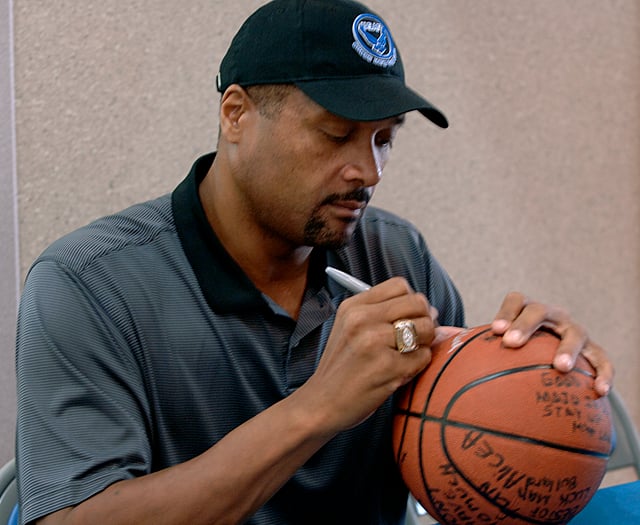
Mark May, offensive lineman for the Redskins between 1981 and 1989, was named one of the 70 Greatest Redskins
In honor of the Redskins' 70th anniversary, on June 13, 2002, a panel selected the 70 Greatest Redskins to honor the players and coaches who were significant on-field contributors to the Redskins five championships and rich history. They were honored in a weekend of festivities, including a special halftime ceremony during the Redskins' 26–21 win over the Indianapolis Colts.[115]
The panel that chose the 70 consisted of former news anchor Bernard Shaw; former player Bobby Mitchell; Senator George Allen (son of coach George Allen); broadcaster Ken Beatrice; Noel Epstein, editor for the Washington Post; former diplomat Joseph J. Sisco; Phil Hochberg, who retired in 2001 after 38 years as team stadium announcer; Pro Football Hall of Fame historian Joe Horrigan; sportscaster George Michael; sports director Andy Pollin; NFL Films president Steven Sabol; and news anchor Jim Vance.[115]
The list includes three head coaches and 67 players, of which 41 were offensive players, 23 defensive players and three special teams players.[115]
Among the 70 Greatest, there are 92 Super Bowl appearances, with 47 going once and 45 playing in more than one. 29 members possess one Super Bowl ring and 26 have more than one. Also, before the Super Bowl, members of the 70 made 18 World Championship appearances including six that participated in the Redskins' NFL Championship victories in 1937 and 1942.[115]
On August 24, 2012, ten more players and personnel were added to the list for the team's 80th anniversary.[116]
Individual awards
| NFL Coach of the Year | |
| Season | Coach |
|---|---|
| 1971 | George Allen |
| 1979 | Jack Pardee |
| 1982 | Joe Gibbs |
| 1983 | |
All-time first-round draft picks
Coaches of note
Current staff
Washington Redskins staff | ||||||
|---|---|---|---|---|---|---|
|
→Front office [159] → More NFL staffs | |||||
| ||||||
Single-season records
Passing yards: 4,917 Kirk Cousins (2016)
Passing touchdowns: 31 Sonny Jurgensen (1967)[117]
Rushing yards: 1,613 Alfred Morris (2012)[117]
Receptions: 113 Pierre Garçon (2013)
Receiving yards: 1,483 Santana Moss (2005)[118]
Pass interceptions: 13 Dan Sandifer (1948)[117]
Sacks: 18.5 Dexter Manley (1986)
Forced fumbles: 6 LaVar Arrington (2003)
Field goals made: 33 Mark Moseley (1983)[117]
Points: 161 Mark Moseley (1983)[117]
Total touchdowns: 24 John Riggins (1983)[117]
Punt return average (minimum 5 returns): 24.3 Derrick Shepard (1987)[119]
Kickoff return average (minimum 5 returns): 42.8 Hail Haynes (1950)[119]
Punting average: 51.4* Sammy Baugh (1940)[120]
** Also an NFL record*
Redskins career records
Passing yards: 25,206 Joe Theismann (1974–1985)[121]
Passing touchdowns: 187 Sammy Baugh (1937–1952)
Rushing yards: 7,472 John Riggins (1976–1979,1981–1985)[121]
Receptions: 889 Art Monk (1980–1993)[121]
Receiving yards: 12,029 Art Monk (1980–1993)[122]
Pass interceptions: 54 Darrell Green (1983–2002)[122]
Field goals made: 263 Mark Moseley (1974–1986)
Points: 1,207 Mark Moseley (1974–1986)[121]
Total touchdowns: 90 Charley Taylor (1964–1977)
Punt return average (minimum 25 returns): 13.8.0 Bob Seymour (1941–1944)[123]
Kickoff return average (minimum 25 returns): 28.5 Bobby Mitchell (1962–1968)[123]
Punting average: 45.1 Sammy Baugh (1937–1952)
Sacks: 91 Dexter Manley (1981–1989)[122]
Forced fumbles: 17 Charles Mann (1983–1993)
Single-game records
NFL records
Offense
The Washington Redskins have had two 14-win seasons, in 1983 and 1991.[125]
The Redskins scored 541 points in 1983, which is the sixth highest total in a season of all time.[126]
The Redskins' 72 points against the New York Giants on November 27, 1966, are the most points ever scored by an NFL team in a regular season game, and the 72 to 41 score amounted to 113 points and the highest-scoring game ever in NFL history.[126] The second-half scoring for the game amounted to 65 points, the second-highest point total for second-half scoring and the third-highest total scoring in any half in NFL history.[126] The Redskins' 10 touchdowns are the most by a team in a single game, and the 16 total touchdowns are the most combined for a game.[127] The Redskins' nine PATs are the second most all-time for a single game, and the 14 combined PATs are the most ever in a game.[128]
The Redskins set a record for most first downs in a game with 39 in a game against the Lions on November 4, 1990. They also set a record by not allowing a single first down against the Giants on September 27, 1942.[129]
The Redskins have led the league in passing eight times: in 1938, 1940, 1944, 1947–48, 1967, 1974 and 1989. Only the San Diego Chargers have led more times.[130] The Redskins led the league in completion percentage 11 times: in 1937, 1939–1940, 1942–45, 1947–48 and 1969–1970, second only to the San Francisco 49ers.[130] Their four straight years from 1942–45 is the second longest streak.
The Redskins' nine sacks allowed in 1991 are the third fewest allowed in a season.[130]
The Redskins completed 43 passes in an overtime win against Detroit on November 4, 1990, second most all-time.[130]
Defense
The Redskins recovered eight opponent's fumbles against the St. Louis Cardinals on October 25, 1976, the most ever in one game.[131]
The Redskins allowed 82 first downs in 1937, third fewest all-time.[132]
The Redskins have led the league in fewest total yards allowed five times, 1935–37, 1939, and 1946, which is the third most.[133] Their three consecutive years from 1935–37 is an NFL record.[133]
The Redskins have led the league in fewest passing yards allowed seven times, in 1939, 1942, 1945, 1952–53, 1980, and 1985, second only to Green Bay (10).[134]
The Redskins had 61 defensive turnovers in 1983, the third most all-time.[135] The turnover differential of +43 that year was the highest of all time.
The Redskins had only 12 defensive turnovers in 2006, the fewest in a 16-game season and second all time. (The Baltimore Colts had 11 turnovers in the strike-shortened 1982 Season which lasted only 9 games.)[136]
Special teams
The Redskins led the league in field goals for eight seasons, 1945, 1956, 1971, 1976–77, 1979, 1982, 1992. Only the Green Bay Packers have ever led more. Their 49 field goals attempted in 1971 is the most ever attempted in a single season. Broken by David Akers (49ers) 2011 Season.[137]
The Redskins and Bears attempted an NFL record 11 field goals on November 14, 1971, and the Redskins and Giants tied that mark on November 14, 1976.[137]
The Redskins 28 consecutive games, from 1988 to 1990, scoring a field goal is third all time.[137]
The Redskins have led the league in punting average six times, in 1940–43, 1945, and 1958, second only to the Denver Broncos.[138] Their four consecutive years from 1940–43 is an NFL record.[138]
The Redskins have led the league in average kickoff return yards eight times, in 1942, 1947, 1962–63, 1973–74, 1981, and 1995, more than any other team.[139]
The Redskins all time FG record is 59yds (4 shy of tying the all-time NFL Record). It was set 11–06–11 by Graham Gano against the San Francisco 49ers at FedexField.
Broadcasting
Radio
Michael is joined by analysts Sonny Jurgensen and Chris Cooley. Jurgensen is a former Redskins quarterback who has been in broadcasting since he retired from the team in 1974, much of that time spent working for his former team. Cooley played tight end for the Redskins from 2004 until 2012 and made the Pro Bowl twice. Cooley replaced Sam Huff, the former Hall of Fame linebacker who played several years with the Redskins, as color commentator following Huff's retirement at the end of the 2012 season.
Another former Washington tight end, Rick "Doc" Walker, is the sideline reporter and Kevin Sheehan hosts the team's pregame show. Longtime Redskins running back/receiver/return man Brian Mitchell also contributes to broadcasts.
Radio affiliates

Map of radio affiliates
Washington Redskins radio affiliates include:[147]
District of Columbia
| City | Call Sign | Frequency |
|---|---|---|
| Washington | WSBN | 630 AM |
Maryland
| City | Call Sign | Frequency |
|---|---|---|
| Cumberland | WCBC | 1270 AM |
| Hagerstown | WWEG-FM | 106.9 FM |
| Snow Hill (Salisbury) | WICO-FM | 101.1 FM |
| WSUX | 1280 AM |
North Carolina
| City | Call Sign | Frequency |
|---|---|---|
| Gastonia | WGNC / W266DC | 1450 AM / 101.1 FM |
| Nags Head | WOBX-FM | 98.1 FM |
| New Bern | WWNB / W280ED | 1490 AM / 103.9 FM |
| Raleigh | WAUG | 750 AM |
| Winterville (Greenville) | WECU | 1570 AM |
| Weldon (Roanoke Rapids) | WSMY | 1400 AM |
Virginia
| City | Call Sign | Frequency |
|---|---|---|
| Alberta (South Hill) | WWDW | 107.7 FM |
| Charlottesville | WCHV | 1260 AM |
| WCHV-FM | 107.5 FM | |
| Fredericksburg | WGRQ | 95.9 FM |
| Gloucester | WXGM-FM | 99.1 FM |
| Harrisonburg | WSVA / W221CF | 550 AM / 92.1 FM |
| Lynchburg | WBRG / W245BG / W286CX | 1050 AM / 96.9 FM / 105.1 FM |
| Martinsville | WHEE | 1370 AM |
| WMVA | 1450 AM | |
| Norfolk | WTAR | 850 AM |
| Richmond | WXGI | 950 AM |
| Petersburg | WTPS / W274BX | 1240 AM / 102.7 FM |
| Roanoke | WFIR / W297BC | 960 AM / 107.3 FM |
| Staunton | WKDW | 900 AM |
| Tappahannock | WRAR-FM | 105.5 FM |
| Waynesboro | WKCI | 970 AM |
| Winchester | WFQX-FM | 99.3 FM |
West Virginia
| City | Call Sign | Frequency |
|---|---|---|
| Charles Town | WMRE | 1550 AM |
| Fisher | WELD | 690 AM |
| Martinsburg | WRNR / W293AM | 740 AM / 106.5 FM |
Television
Telecasts of preseason games not shown on national networks are aired in HD exclusively on Comcast SportsNet in the overall Mid-Atlantic region. WRC-TV broadcasts preseason games in SD in the Washington, D.C. area. Comcast SportsNet also airs a pregame show and an extensive game recap program after each Redskins regular season Sunday game. Kenny Albert usually does play-by-play, while former Redskins players Joe Theismann and Clinton Portis respectively serve as the color analyst and sideline reporter. In the regular season, most games are shown on Fox NFL. The main exceptions are when the Redskins host an AFC team or play at night.
U.S. presidential election superstition
For 17 of the past 19 United States presidential elections, a win for the Redskins' last home game prior to Election Day coincided with the incumbent party winning re-election. The exceptions were in 2004, when Republican incumbent George W. Bush won re-election despite the Green Bay Packers beating the Redskins,[148] and again in 2012, when Democratic incumbent Barack Obama retained the presidency on November 6, despite the Redskins losing to the Carolina Panthers on November 4, 21–13.[149] Other than these exceptions, this "Redskins Rule" has proven true since 1936 when they won and incumbent Franklin D. Roosevelt won re-election, prior to the Redskins' move from Boston in 1937.[150] The rule was discovered in 2000 by Steve Hirdt, former executive vice president of the Elias Sports Bureau, while searching for discussion ideas for a game between the Redskins and Tennessee Titans.[151]

